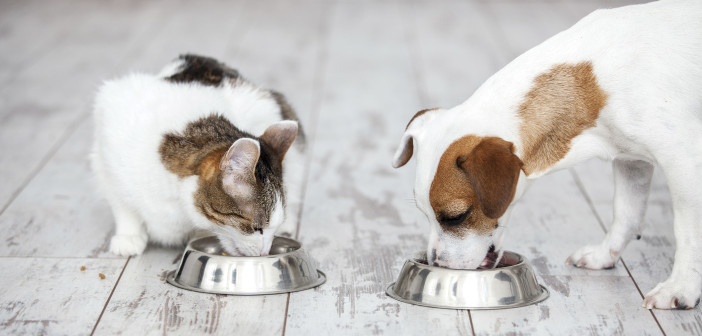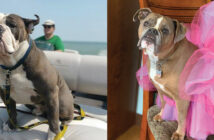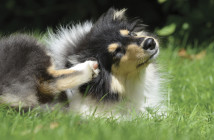Your pet relies on you for everything – including making sure it’s well-fed. A nutritious diet and healthy weight can have a huge impact on your pet’s energy level, lifespan, and overall happiness. But, with so many different foods out there, it’s hard to choose the best one. And, how do you know if your pet is eating too little, too much or just the right amount?
With the variety of pet food formulas available, it is important that you talk to your vet about specific needs. With dogs and cats being the most popular pets, let’s begin there.
Ingredients are Key. You have to read the ingredients list so that you aren’t fooled by the buzz words and packaging. For cats and dogs, especially, the most important ingredient to look for is MEAT.
Cats and dogs are carnivores – they thrive on a meat-based diet. Grains (carbs) are added to pet food because they’re cheaper than meat, and they hold the kibbled bits together. Look for whole food sources at the very top of the ingredient list like beef, turkey, lamb or chicken – clear, one-word descriptions are best. Avoid any formula that uses unidentified sources, described non-specifically as “meat,” “animal” or “poultry.”
The second ingredient on the list should be vegetables (avoid corn, soy, wheat, beet pulp or grain fragments). Whole fruits are fine as a portion of the ingredients – especially if they are replacing the grains. Just like with your own food, if there is a huge list of ingredients and you aren’t quite sure what some of them are, it is probably best to choose another option.
Canned Food or Kibble?
Canned PROS: Many pet owners and vets find that canned pet foods are better than kibble because they tend to contain more meat protein and fewer carbohydrates. They also don’t have artificial flavorings or colorings and fewer synthetic preservatives because of the air-tight packaging. Another added benefit is the moisture-heavy canned foods help pets maintain a healthy weight. Cats and dogs that eat wet food feel fuller faster, so they tend not to overeat. And, if your older pet has trouble chewing, softer food is easier to eat.
Kibble PROS: There is no denying that in the convenience and cost categories, kibble wins, hands-down. Another consideration: you must refrigerate open cans of food, and never leave it in your pet’s bowl for more than an hour or two. If it sits out, it can grow bacteria.
Can’t choose? Use both! There are times when either kibble or canned is the right choice for your pet. And, mixing them together is another feeding method your pet will appreciate. Whether you use kibble or canned, just make sure to check the ingredients and the amount you are feeding your pet, in order to keep them healthy and happy!
Is Petey Too Plump?
All pet foods have feeding guidelines, but, you should make adjustments based on your individual pet. Not only do different breeds have different needs, the amount they eat should reflect their energy requirements. Just like people have different metabolisms, some pets eat and burn food much faster than others.
To help you judge if your pet is eating the right amount, there are two key areas to watch: the ribs and the waistline. If you can see the outline of your pet’s ribs, they’re not getting enough to eat. With both cats and dogs, there should be a narrowing at the stomach. Like humans, the waistline often fills out first if they’re overweight.
Tricks with Treats
Treats can be a very useful part of your pet’s diet, and they can be helpful for training purposes. But, how many treats does your pet get in a day? Too many treats could be making them unhealthy. A key number to remember is ten. No, not ten treats! Only ten percent of your dog’s daily caloric intake should be from treats. Talk with your vet about how many calories your pet needs, and what treats are recommended for its specific breed.
Pro Tip: avoid treats that are too high in sodium. Just like in your pets’ food, avoid corn and other filler ingredients that can make them unhealthy. And, come on – stop feeding Petey from the table already!
What About Polly?
Remember that birds and other pets have specialized nutritional needs, and they need to eat more than just seeds. Along with a premium pellet food, birds need fresh veggies, chew toys to keep their beak trim and a conditioning perch to wipe their beak on to keep it clean.
For Fishy Friends
Purchase the fish food created for the species you have. They may all look the same to you, but for example, beta food and goldfish food are different in the amounts of protein and carbs they contain. Although fish (like goldfish) can go up to two weeks without any food, it is best to provide an automatic fish-feeder or feeding block if you’ll be gone for an extended time. As with most pets, feeding them human food such as crackers and bread is not recommended. Instead, there are special fish treats you can pick up to give Nemo some extra love.
The Bottom Line
- Take care to check on your pet’s specific breed or species, as they all need specialized care.
- Read pet food ingredients before you buy it to ensure the best quality.
- Keep track of how much they are eating and adjust the amount if your pet shows signs of being over- or under-fed.
- Visit your vet. Your pet’s doctor can answer any questions and make tailored recommendations.








